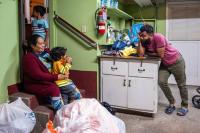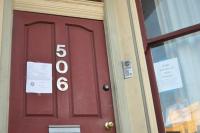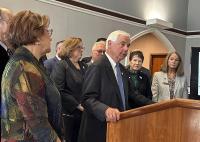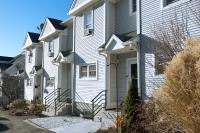
No Shelter: Homelessness and the Housing Crisis
Report For America explores how the housing crisis is impacting the most vulnerable groups, increasing homlessness rates across the U.S.
INTRODUCTION
The housing and homelessness crisis in the United States is reaching alarming proportions, with half of all renters paying more than 30 percent of their income towards rent and utilities. The demand for housing outpacing supply has led to skyrocketing costs, impacting communities nationwide. The problem is decades in the making, as rents have risen magnitudes faster than wages, especially for families earning $45,000 or less, where wage growth in renter households has been minimal or nonexistent.
These and other factors have contributed to a 2023 record-high of over 650,000 homeless people, with 40 percent of these individuals living unsheltered, a nearly 50 percent increase from 2015. The end of federal pandemic assistance, including eviction moratoriums and emergency rental aid, further exacerbates the situation.
The reporting highlighted in this story map reinforces the direct connection between the housing crisis and homelessness. Divided into three parts —The Housing Crisis, Homelessness, and Exploring Solutions — it delves into 17 stories reported by 11 Report For America corps members. Their stories explore various facets of the issue, from prolonged stays at underfunded homeless shelters and evicted families sleeping in cars for months on end to the struggles of those ineligible for public assistance and the daily uncertainties of living without shelter. Through thoughtful reporting and compassionate visual storytelling, the stories unveil how this issue is fracturing families, upending communities, and increasing obstacles for an already vulnerable population.
Each year, The National Low Income Housing Coalition (NLIHC) measures the availability of affordable low-income housing. Their 2023 report revealed a national shortage of 7.3 million affordable rental homes, with only 33 affordable homes for every 100 extremely low-income renter households. All of the states outlined in the story map – Texas, Colorado, California, Florida, New York, Wisconsin, New Hampshire, Illinois, Connecticut, and Ohio – rank among the worst in the country for available affordable rental homes, with rates between 23 and 40 affordable homes per family.
Corps members' comprehensive reporting not only sheds light on the national and individual scope of this crisis but also reveals a glimmer of hope on the horizon through the stories of communities and organizations that are experimenting with new ways to address this crisis. Despite the challenges, the story map presents an opportunity to explore solutions for a future where stable housing is accessible and widespread. As the crisis unfolds, it becomes increasingly evident that addressing the shortage of affordable homes is not just a matter of personal struggle -- it's imperative for the well-being of individuals, families, and the nation as a whole.
AFFORDABLE HOUSING CRISIS

Struggling Families Ineligible for Assistance in Wisconsin
Struggling Families Ineligible for Assistance in Wisconsin. Click to expand.
Shannon Pikka, a single mother working in construction in Green Bay, earns just under $27 per hour, which is higher than the median earnings in her area but not enough to support two kids by herself. Pikka represents a growing segment of workers known as ALICE (Asset Limited, Income Constrained, Employed), that struggle to cover basic expenses but are ineligible to receive public assistance.

Single Mothers Working Multiple Jobs in Colorado
Single Mothers Working Multiple Jobs in Colorado. Click to expand.
Amidst Colorado's escalating living costs, the stories of two women, Justice Wilson and Angeles Gutierrez, epitomize the struggles many endure to afford housing.

Competitive Housing Market in Illinois
Competitive Housing Market in Illinois. Click to expand.
On their minimum wage salaries, Bloomington-Normal residents Anakin Fox and Syd Sterling are being priced out of their city. Facing homelessness, their struggle to secure a rental property is compounded by the competitive and demanding local housing market.

Family's Housing Instability Worsened by Pandemic in California
Family's Housing Instability Worsened by Pandemic in California. Click to expand.
Forced to vacate her apartment, Bay Area mother Mirna Arana was given 30 days to find a new place – an already difficult task compounded by the financial instability caused by the pandemic, an injured husband out of work, young children, no lawyer, and limited resources.

Retired Homeowner's Concerns in New Hampshire
Retired Homeowner's Concerns in New Hampshire. Click to expand.
In two years, Concord homeowner April Stoddard saw a 55 percent increase in her property tax bill. She’s 75 and, like many retirees, on a fixed income. Combined with the rising cost of living, including food and gas, the change has her questioning if the city’s goal is to force residents out.
INCREASED HOMELESSNESS

Evicted Families in Connecticut
Evicted Families in Connecticut. Click to expand.
In the months following the Radford family’s eviction due to their 20-year-old daughter's battle with opioid addiction, they’ve been relying on soup kitchens, friends' houses, and their car for shelter.

Fears of Returning to Homeless Life Florida
Fears of Returning to Homeless Life Florida. Click to expand.
Homelessness has surged in Florida, with unsheltered cases increasing by 38 percent in the past year and 75 percent since before the pandemic. The Homeless Services Network of Central Florida stated that the vast majority of people using their services were experiencing homelessness for the first time in their lives.

Rising Homelessness Rates for Kids in Texas
Rising Homelessness Rates for Kids in Texas. Click to expand.
After withholding rent to pressure her landlord into fixing the mold problem in her home, Shynice Stevens, a 30-year-old single mother of four, was evicted. For the next five months, Stevens and her children – whose ages range from 1 to 14 – lived in her car.

Economic Growth Displacing Residents in Ohio
Economic Growth Displacing Residents in Ohio. Click to expand.
The rapid growth of Ohio’s Hocking Hills State Park – who’s annual visitor count at 6 million surpasses that of Yellowstone – has had unintended consequences on the housing market.
ADDRESSING THESE PROBLEMS

Nonprofit Eviction Relief Program in Ohio
Nonprofit Eviction Relief Program in Ohio. Click to expand.
Advocates for Basic Legal Equality (ABLE), an Ohio legal aid nonprofit, are addressing the rising eviction rates in Ohio that are impacting low-income rural communities. ABLE has launched a rural eviction relief program to tackle the issue.

Historic Funding Towards Housing in New Hampshire
Historic Funding Towards Housing in New Hampshire. Click to expand.
There’s a renewed focus on housing in the New Hampshire state legislature, with an “unprecedented number” of approaches to address the state’s housing crisis.

Unique and Affordable Housing Model in Connecticut
Unique and Affordable Housing Model in Connecticut. Click to expand.
The Brookside project is a housing co-op in Connecticut, where six corporations made up of tenants self-govern and self-manage their buildings. This unique model allows residents to buy shares, granting them not only voting rights but also the privilege to live in the homes within the co-op.

Mayor's Steps To Address Housing Crisis in New York
Mayor's Steps To Address Housing Crisis in New York. Click to expand.
New York City Mayor Eric Adams has proposed a series of housing initiatives and zoning changes to address the city's severe housing shortage and affordability crisis.